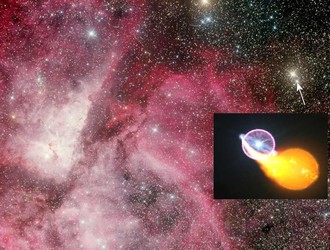
Polish resources were essential in understanding this burst of light.
In astronomy, the word Nova describes a phenomenon that makes a “new star” appear in the Sky. In reality, this is a powerful explosion which occurs on the surface of an already existing star. The explosion produces an enormous amount of energy increasing star’s brightness by thousands or even millions of times. Some can become bright enough to be seen by the naked eye, and hence an apparently new star emerges. These Novae occur in stars called white dwarfs that have a close companion star orbiting it. The white dwarf strips material from the companion star, this material piles up and eventually undergoes an explosive nuclear fusion. While for many years astronomers have thought that nuclear burning of material on the surface of the white dwarf directly powers all the light from the explosion, more recently it has been suspected that “shocks” from the explosion might power most of the brightness. Now, an international team of researchers, including astrophysicists from the Nicolaus Copernicus Astronomical Center in Warsaw, has found that it is indeed shocks that cause most of the nova’s brightness. Essential for this finding were observations from the BRITE-Constellation space mission and the SALT telescope, both of which have a significant Polish contribution.
“This is a new way of understanding the origin of the brightness of novae and other stellar explosions,” says Dr Elias Aydi, from Michigan State University and lead author of the paper. “Our findings present the first direct observational evidence, from unprecedented space observations, that shocks play a major role in powering these events.” These shocks form like the sonic booms in a supersonic jet airplane exceeding the speed of sound. In a nova explosion, the shocks produce light rather than sound. “When material blasts out from the white dwarf,” says Aydi, “it is ejected in multiple phases and at different speeds. These ejections collide with one another and create shocks producing much of the light.” Another effect of those shocks are gamma-rays, electromagnetic radiation of the highest energy that the astronomers detected from this star, known as Nova V906 Carinae. Using NASA’s Fermi Gamma-ray Space Telescope, they showed that V906 Carinae had the brightest gamma-rays ever observed for a nova, proving that it hosts energetic shocks.
Perhaps the biggest surprise was that one of the six nanosatellites of the international BRITE constellation of cube-sats just happened to be looking at the part of the sky where the nova occurred. “Our BRITEs observe a few small selected regions of the sky. The probability that a Nova outburst visible to the naked eye occurs in one of those regions has been estimated with one in a few millions. This is about the same chance as winning the lottery,” explains Prof. Gerald Handler, from the Nicolaus Copernicus Astronomical Center in Warsaw, Principal Investigator of the Polish BRITE Satellites and co-author of the study. It was quickly realized that additional measurements would be needed to understand this Nova, and the Southern African Large Telescope (SALT) was alerted. “It is the combination of multiple instruments, such as the tiny 3-cm BRITE telescopes and the giant 10-m SALT that allowed us to obtain such a clear picture of what’s happening in V906 Car,” Prof. Joanna Mikołajewska from the Nicolaus Copernicus Astronomical Center in Warsaw, member of the Polish SALT science team and co-author of the study, points out. The team estimates that V906 Car is about 13,000 light years from Earth. This means that when the nova was first detected in 2018, it had actually happened 13,000 years ago. The research is detailed in a recent paper published in Nature Astronomy.
Illustration 1: V906 Car pictured in outburst and marked by a white arrow. HD 92063 is
the brighter nearby star (Image credits: A. Maury & J. Fabrega).






